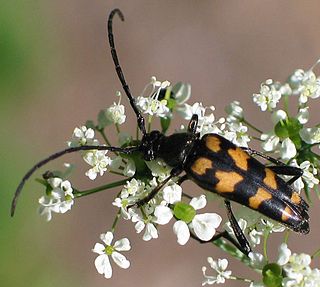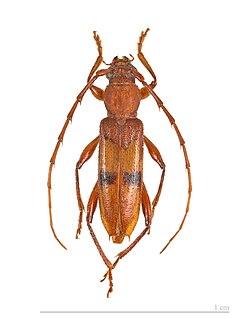| Eclipta | |
|---|---|
| Scientific classification | |
| Kingdom: | |
| Phylum: | |
| Class: | |
| Order: | |
| Suborder: | |
| Family: | |
| Genus: | Eclipta |
Eclipta is a genus of beetles in the family Cerambycidae, containing the following species: [1]

Beetles are a group of insects that form the order Coleoptera, in the superorder Endopterygota. Their front pair of wings are hardened into wing-cases, elytra, distinguishing them from most other insects. The Coleoptera, with about 400,000 species, is the largest of all orders, constituting almost 40% of described insects and 25% of all known animal life-forms; new species are discovered frequently. The largest of all families, the Curculionidae (weevils) with some 80,000 member species, belongs to this order. Found in almost every habitat except the sea and the polar regions, they interact with their ecosystems in several ways: beetles often feed on plants and fungi, break down animal and plant debris, and eat other invertebrates. Some species are serious agricultural pests, such as the Colorado potato beetle, while others such as Coccinellidae eat aphids, scale insects, thrips, and other plant-sucking insects that damage crops.
- Eclipta aberlenci (Tavakilian & Peñaherrera-Leiva, 2005)
- Eclipta aegrota (Bates, 1872)
- Eclipta amabilis (Melzer, 1934)
- Eclipta amanoaphila (Penaherrera-Leiva & Tavakilian, 2003)
- Eclipta anoguttata (Bates, 1873)
- Eclipta astrigae (Tavakilian & Penaherrera-Leiva, 2003)
- Eclipta atripes (Fisher, 1952)
- Eclipta bauhiniae (Penaherrera-Leiva & Tavakilian, 2004)
- Eclipta bilineaticollis (Zajciw, 1965)
- Eclipta bipunctata (Melzer, 1934)
- Eclipta bistriaticollis (Zajciw, 1965)
- Eclipta bivittata (Fuchs, 1961)
- Eclipta bivitticollis (Fisher, 1952)
- Eclipta brachialis (Bates, 1873)
- Eclipta brasiliensis (Fisher, 1947)
- Eclipta brevipennis (Melzer, 1934)
- Eclipta castanea (Bates, 1873)
- Eclipta championella (Bates, 1880)
- Eclipta collarti (Fuchs, 1959)
- Eclipta costipennis (Giesbert, 1991)
- Eclipta cribripennis (Bates, 1873)
- Eclipta curtipennis (Zajciw, 1966)
- Eclipta cyanea (Bates, 1885)
- Eclipta discolor (Gounelle, 1911)
- Eclipta eirene (Newman, 1841)
- Eclipta eperuaphila (Tavakilian & Peñaherrera-Leiva, 2005)
- Eclipta erythrodera (Bates, 1873)
- Eclipta eunomia (Newman, 1841)
- Eclipta fanchonae (Tavakilian & Penaherrera-Leiva, 2003)
- Eclipta faurei (Penaherrera-Leiva & Tavakilian, 2003)
- Eclipta flavicollis (Bates, 1873)
- Eclipta fritschei (Gounelle, 1913)
- Eclipta giuglarisi (Penaherrera-Leiva & Tavakilian, 2004)
- Eclipta gracilis (Fisher, 1952)
- Eclipta guianensis (Penaherrera-Leiva & Tavakilian, 2004)
- Eclipta igniventris (Giesbert, 1991)
- Eclipta lanuginosa (Bates, 1873)
- Eclipta lateralis (Fisher, 1952)
- Eclipta lauraceae (Penaherrera-Leiva & Tavakilian, 2004)
- Eclipta liturifera (Bates, 1873)
- Eclipta malacodermoides (Penaherrera-Leiva & Tavakilian, 2003)
- Eclipta malthinoides (Bates, 1870)
- Eclipta melzeri (Zajciw, 1967)
- Eclipta minuens (Giesbert, 1991)
- Eclipta monteverdensis (Giesbert, 1991)
- Eclipta nais (Gounelle, 1911)
- Eclipta nigriventris (Melzer, 1934)
- Eclipta notaticollis (Gounelle, 1911)
- Eclipta notatipes (Tavakilian & Peñaherrera-Leiva, 2005)
- Eclipta pallidicornis (Zajciw, 1966)
- Eclipta perplexa (Gounelle, 1911)
- Eclipta picturata (Gounelle, 1911)
- Eclipta pilosipes (Penaherrera-Leiva & Tavakilian, 2004)
- Eclipta prolixa (Bates, 1873)
- Eclipta pseudoruficollis (Tavakilian & Peñaherrera-Leiva, 2005)
- Eclipta quadrispinosa (Gounelle, 1913)
- Eclipta ramulicola (Gounelle, 1911)
- Eclipta romani (Aurivillius, 1919)
- Eclipta ruficollis (Bates, 1870)
- Eclipta sallaei (Bates, 1885)
- Eclipta seabrai (Zajciw, 1960)
- Eclipta semiflammea (Gounelle, 1911)
- Eclipta seminigra (Gounelle, 1911)
- Eclipta signaticollis (Melzer, 1922)
- Eclipta socia (Melzer, 1934)
- Eclipta subcastanea (Zajciw, 1966)
- Eclipta taraleaphila (Tavakilian & Penaherrera-Leiva, 2003)
- Eclipta thoracica Bates, 1873
- Eclipta transversemaculata (Tavakilian & Peñaherrera-Leiva, 2005)
- Eclipta vasconezi (Penaherrera-Leiva & Tavakilian, 2004)
- Eclipta vicina (Melzer, 1927)
- Eclipta vitticollis (Bates, 1873)
Eclipta aberlenci is a species of beetle in the family Cerambycidae. It was described by Penaherrera-Leiva and Tavakilian in 2005.
Eclipta aegrota is a species of beetle in the family Cerambycidae. It was described by Bates in 1872.
Eclipta amabilis is a species of beetle in the family Cerambycidae. It was described by Melzer in 1934.


